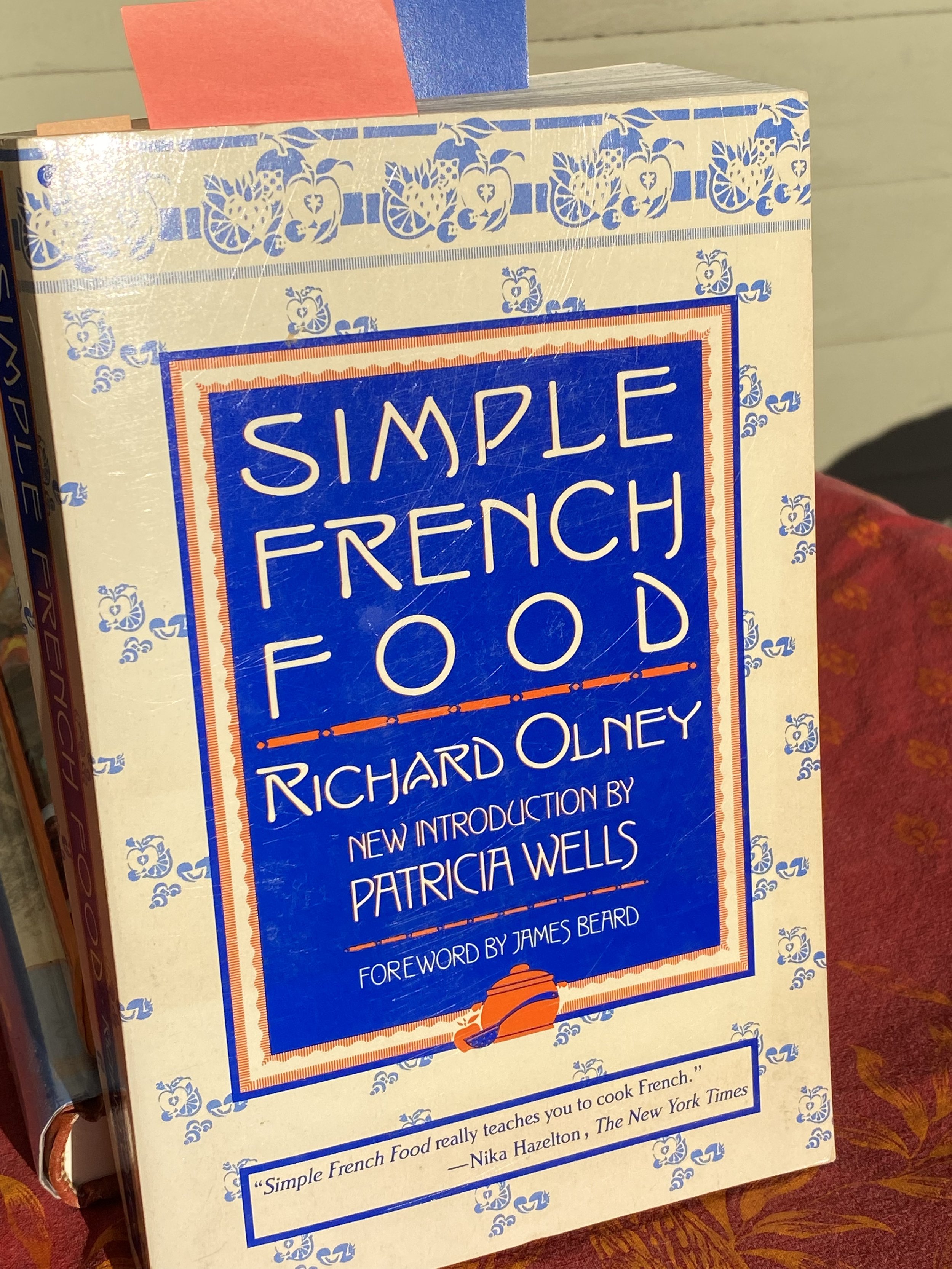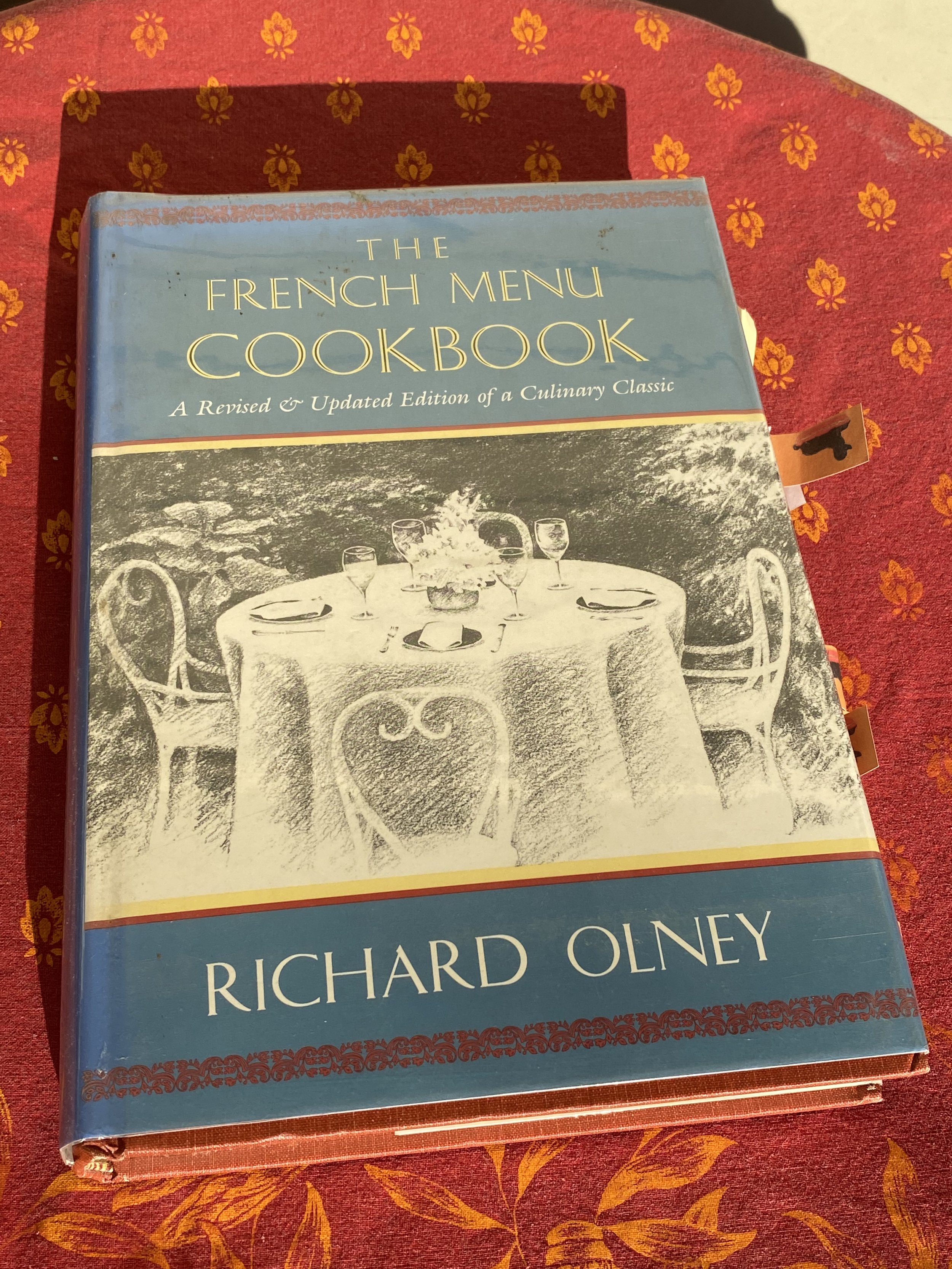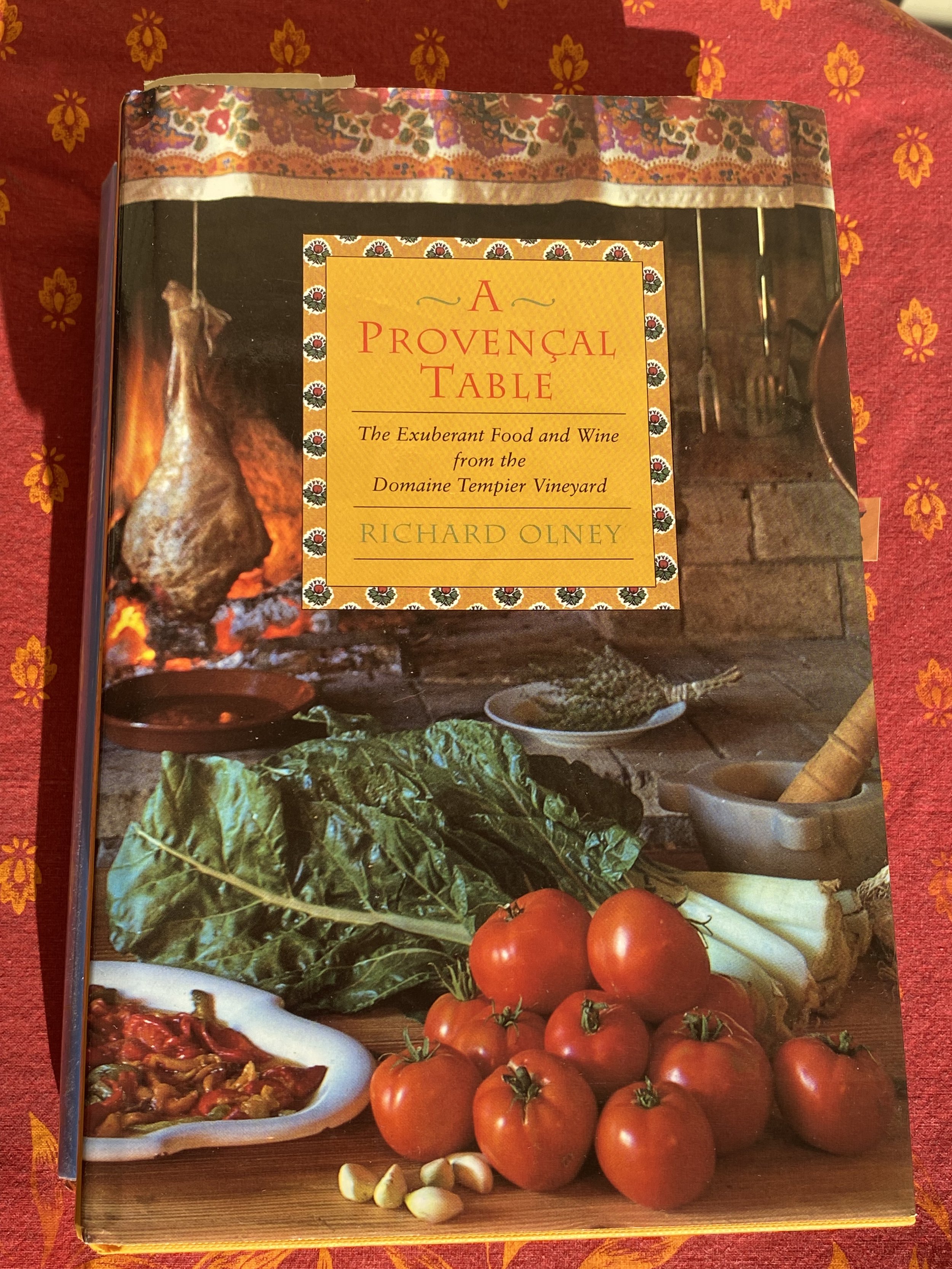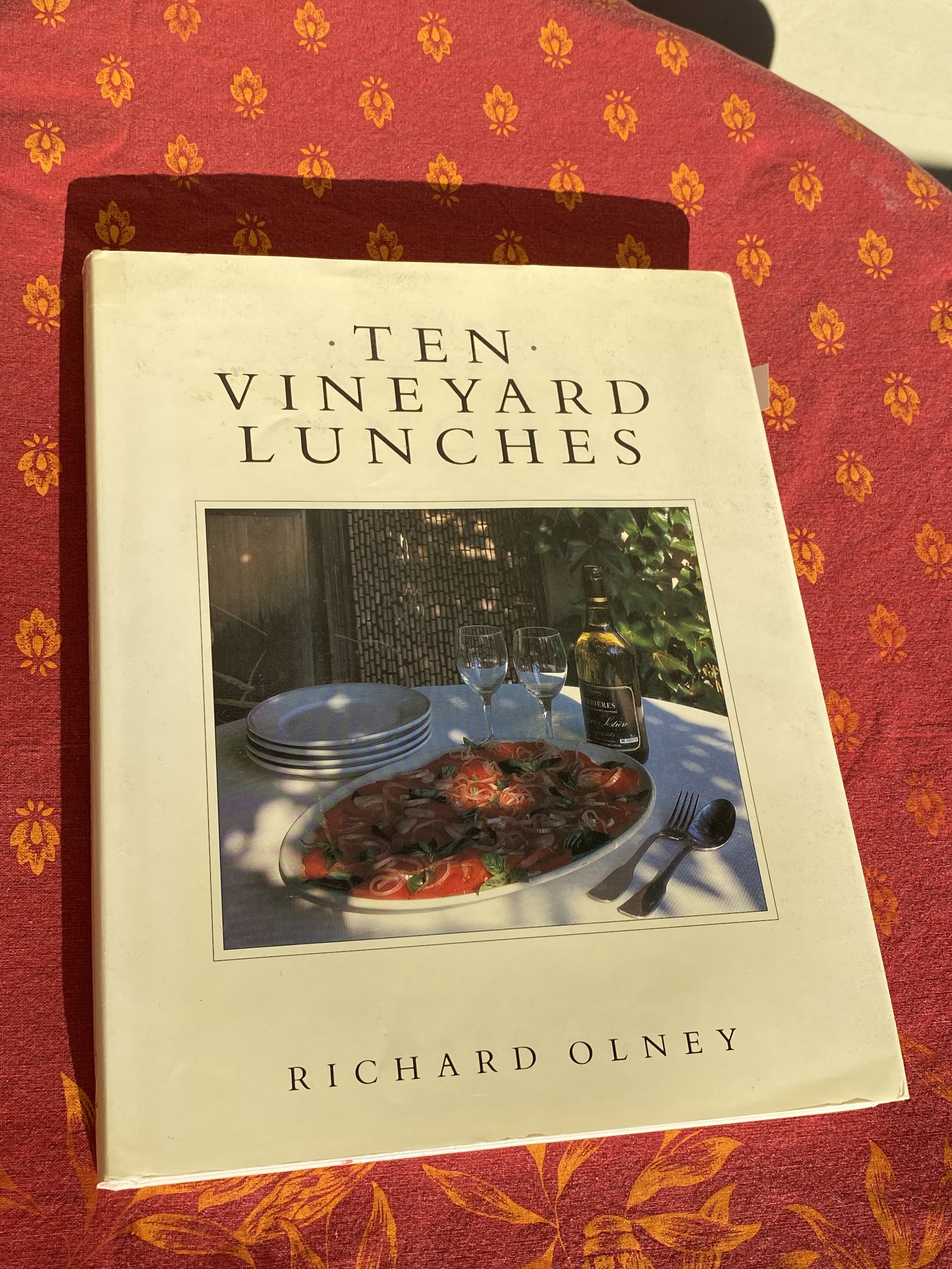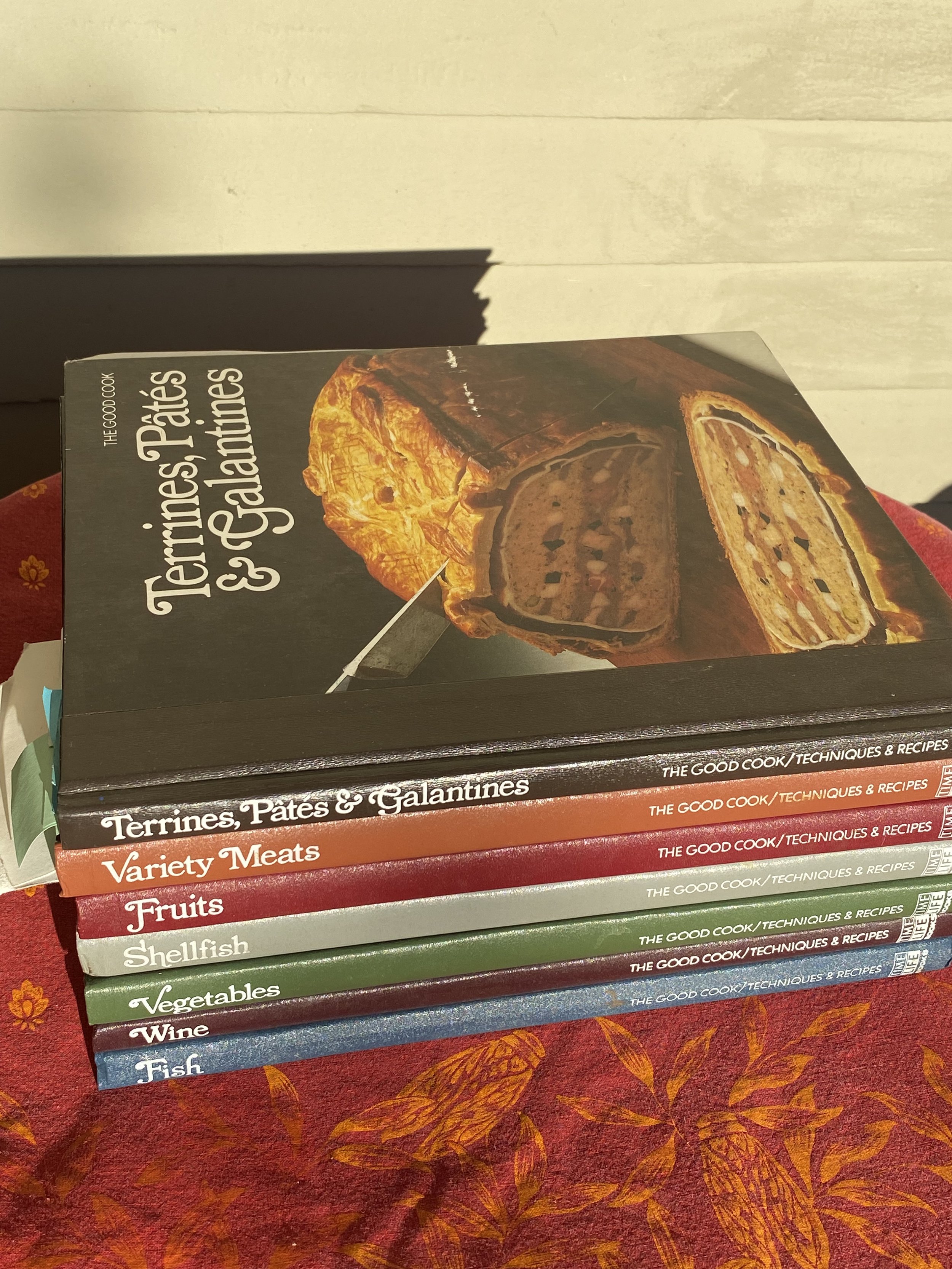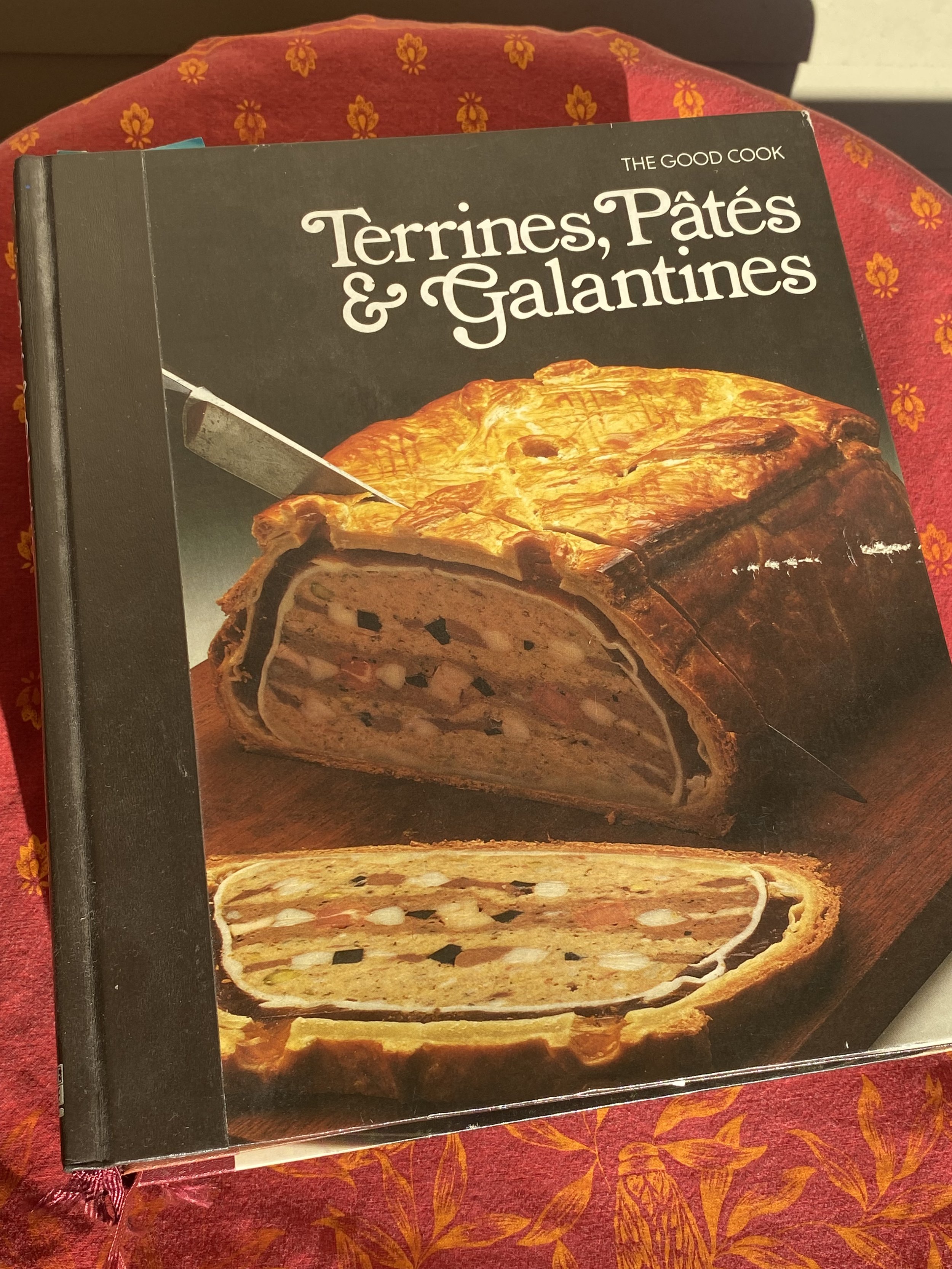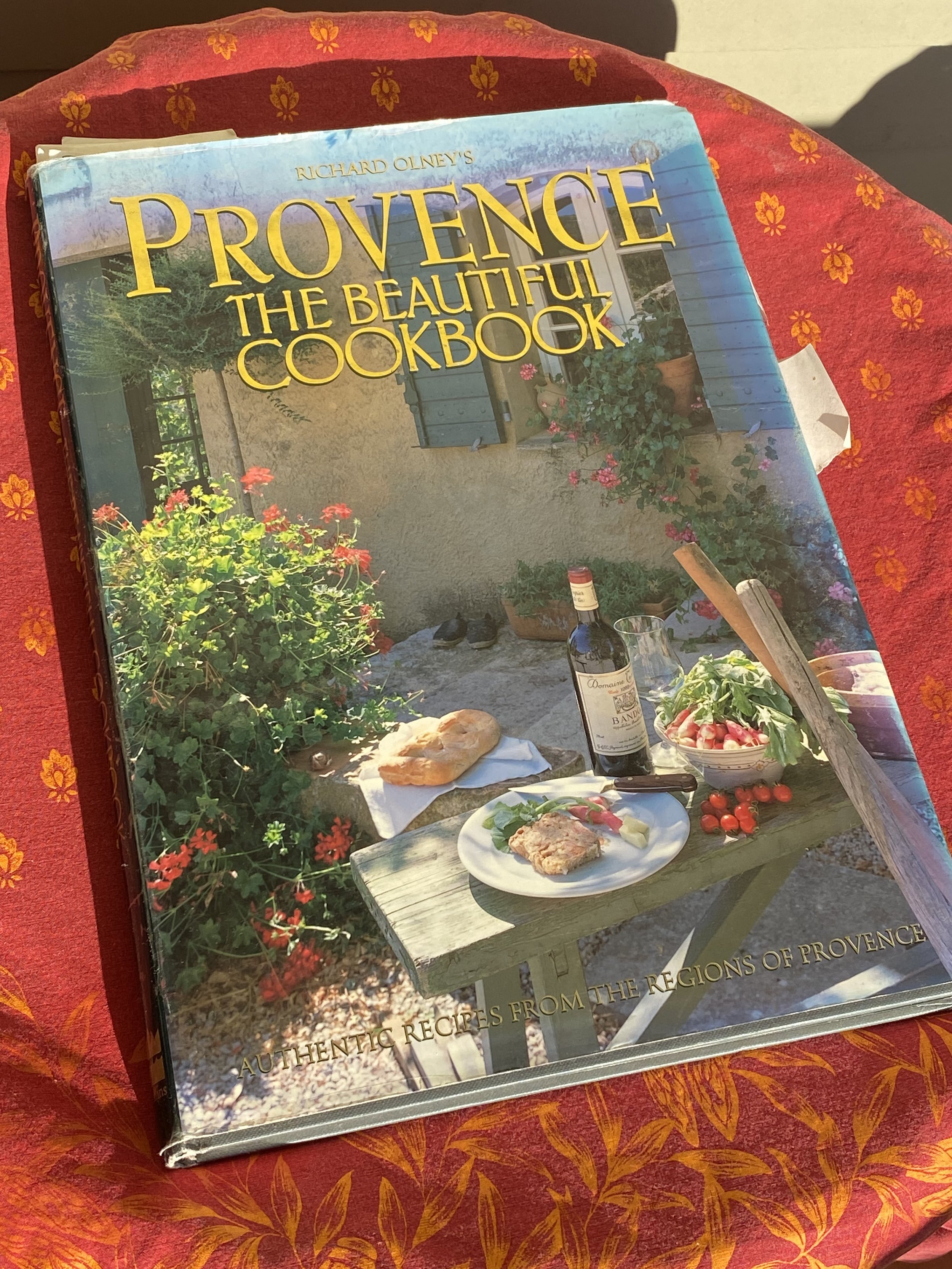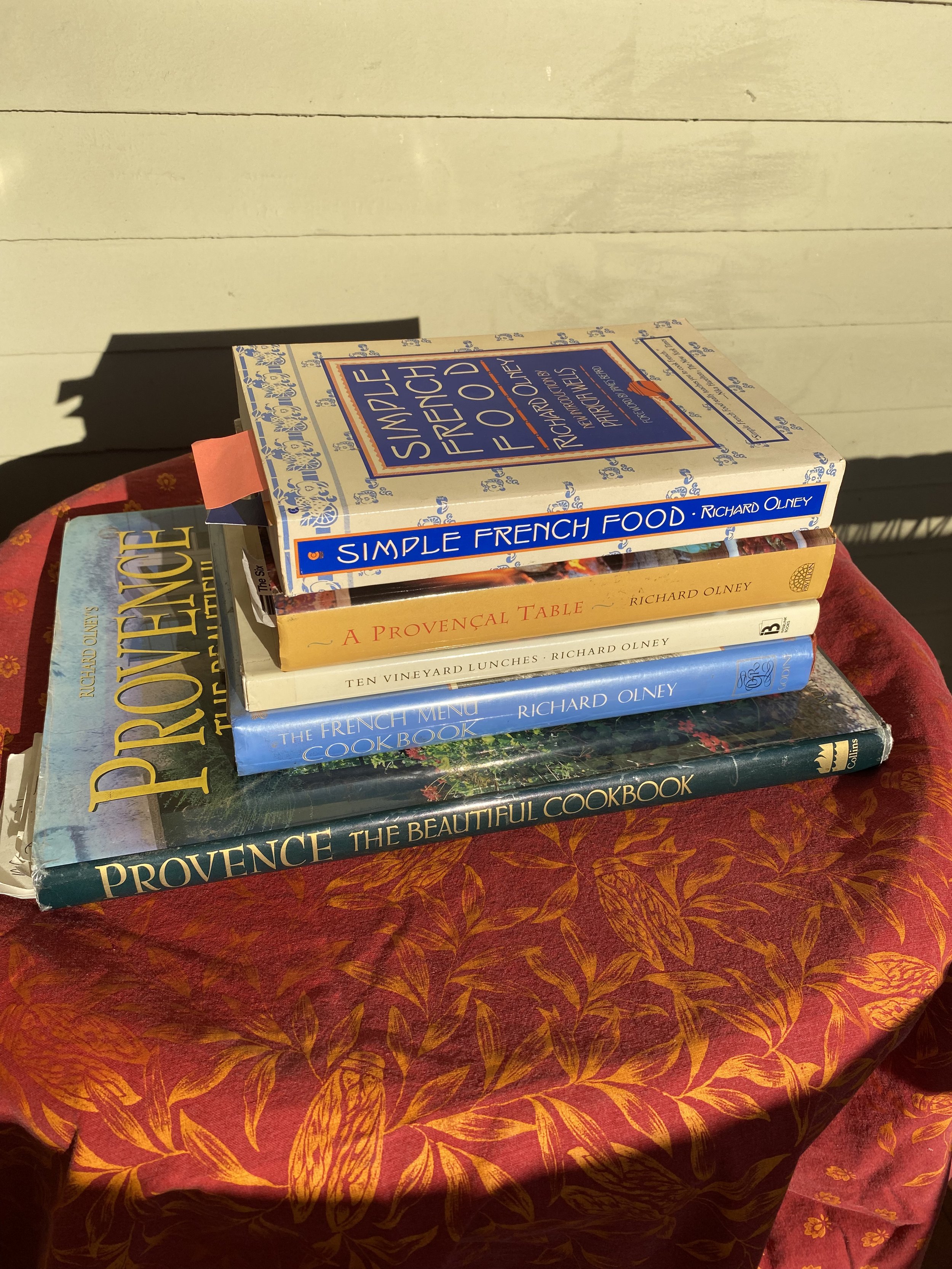Richard Olney Comes for Dinner at My House
My study group thrilled me by announcing the theme for the year was dinner with anyone from history. I knew immediately who I was inviting, Richard Olney.
At the top of my long list of food and wine writers is Richard Olney (1927-1999). I love reading his clear and concise prose. His instructions leave no doubt what you need to do. His recipes yield delicious results. The breath and depth of his knowledge is superior to anyone I can think of. Although he later published numerous fine cookbooks in English for the American market, he began as a monthly columnist for French publications aimed at restaurateurs and winemakers, Cuisine et Vins de France (CVF) and La Revue du Vin de France (RFV). For the French publisher, Henri Flammarion, he wrote two well-regarded books on the wines of Chateau d’Yquem, which has remained in the same family for four centuries and the wines of Domain Romanee-Conti with eleven centuries of history. These food and wine projects were his hobby. His first love and life long activity was painting. He studied painting and art history at the University of Iowa and the Brooklyn Museum Art School. He had solo exhibitions in Paris and New York.
He moved to Paris in 1951 and lived almost fifty years in France, mostly in Provence, not the posh side with Michelin restaurants and celebrities, but the poor side with laborers, like Richard, who worked with his hands everyday. One of his French friends, a journalist, Michael Lemonnier, wrote several articles about Richard Olney living so well in his hillside garden on almost no money, painting, writing, cooking--the idealized life of the artist from Rousseau and the Enlightenment. The French people loved him for this. He completely embraced the French passion for fresh, local, seasonal ingredients with menus that changed as the market produce did.
For our dinner together I would have loved to sit on his terrace under the grape arbor over looking the olive trees on his property in the hills outside the village of Sollies-Toucas, close to Toulon on the Mediterranean in Provence. It would have been wonderful to go down the road to Domain Tempier in Bandol, sort of his second home, where he spent so many afternoons and evenings with his friends and winemakers Lulu and Lucien Peyraud. It was easier for me to invite him to dinner at my house and serve what was frequently on the menu in Provence: sea urchins with champagne, rotisserie roasted leg of lamb with sautéed artichokes and potatoes, and a green salad with both Domain Tempier’s Bandol Rose and Red. For dessert I wanted to skip the fresh goat cheese Richard often served with fruit to present what he thought was one of the best ever pairings – his mother’s apple pie with Château d’Yquem, a 30 year old sauterne from Bordeaux. That half bottle cost me a bundle but was worth it. The other wines are reasonably priced and he believed were the best choices with the Provencal dishes. As he said, never bother with any wines but Provincial wines when serving the food of Provence; they blunt the bright light of the food. The wine of Provence is sunny just like the food. I didn’t want any other guests; cooking for two is makes the service easy and I didn’t want to share him with anyone else.
Q: My first question is, “Richard, how did a small town guy from Marathon, Iowa become a big time food and wine writer in France?”
A: He carefully considered the question before he answered, “Growing up in a farming community, gardening, raising chickens, foraging, and living with seven brothers and sisters in a small house, instill in you the American and French virtues of economy, simplicity and thrift, as well as happiness despite little or no plumbing. My two apartments in Paris featured one rustic communal toilet for the whole building. I’m used to that. My house in Provence had no plumbing or running water for years. The steep goat trail up to my house kept out some visitors, the lack of water kept out others, but not enough. For a man who wanted to live alone, I received a great deal of visitors. This is mostly because I’m a good cook and have a decent wine cellar. My record collection is quite good too and dancing until dawn on my terrace is popular with my guests. Even when I travel people try to get me to do the cooking. Thank you for cooking for me. I enjoy all the pleasures of the table and I embrace the French habit of dining on good food and drinking wine even when money is scarce. The community of being at the table with conversation is sacred to me. I think the French spend more money on food, even poor people, than other nationalities. It’s a priority that I live by. That’s a long answer for why the French people embraced me philosophically. I was active with wine tasting organizations, which introduced me to the world of wine, winemakers and appreciators. We didn’t drink wine or any alcohol in Iowa. The wine tasters made many expeditions every year to the countryside to drink wines. Not everyone wants to spend long days in cold cellars tasting hundreds of wines and spitting in a bucket. You have to be thoughtful about each taste. You have to refresh your palate with lunch or dinner -- or champagne I find works well. I was so fascinated with wine and the cuisine I focused on learning all I could. We had formal dinners in restaurants that were beyond my usual budget. I found kindred spirits this way and made lifelong friends with people who didn't mind that I was a penniless painter. It was the wine publications that first approached me about writing for them about my tasting experiences. I never knew I could write until I tried it. No one is more surprised than I am at being a writer of cookbooks. I always think of my siblings as much more educated, successful people than I am. One brother is a poet and professor, two brothers are doctors and one of my sisters is a painter too. We are all very close and have corresponded all our lives and get together in the summer in Europe to travel together and at Christmas in the U.S. The most important point is that I enjoy cooking. I have studied it since my undergraduate years at the University of Iowa. I know Escoffier quite well from reading and often quote him to defend French challengers to my techniques. My cookbook collection includes 18th and 19th century French cookbooks. I know the history and the traditional techniques and from that I improvise like a jazz musician. That’s how I think everyone should cook. Exact measurements and temperatures enslave a cook. Use a pinch, a handful, a splash until the taste is right. Cooking requires using all your senses. You have to see, feel, hear, smell and taste. It’s a very pleasing process to me.”
Q: “Richard, it seems logical and probable the way you explain it. I couldn’t agree with you more about how pleasing it is. People ask me if I ever think about anything else and I have to respond, “not too often.” The next thing I want to hear about is how you became friends with Lulu and Lucien Peyraud. I love the cookbook you wrote about them, A Provencal Table The Exuberant Food and Wine from the Domaine Tempier Vineyard. The Peyrauds put Bandol on the wine map. They are natural hosts and make everyone feel special. Lulu is an extraordinary cook of whatever is most alive at the market. I served her Baked Halibut with Mushrooms and Cream for a group of discriminating eaters. It’s more than 15 years ago and the dish is mentioned whenever I see the people. The Domaine Tempier wine is available here to so I’ve tasted it but it’s not as reasonable as it used to be.”
A: There’s a big wine expo in Paris every year where hundreds of winemakers bring their new vintages looking for customers. I met Lucien in 1955 at the expo, four years after I moved to Paris, and bought several cases of the 1953 he was selling. Since then I have bought wine every year from him. He and Lulu love to receive and it’s glorious to go for lunch and stay the night with them. The house, winery and property are beautiful. It’s about 30 minutes drive from my house in Provence and they come to get me and bring me home because I don’t drive. The whole family, all the kids and spouses help. They host numerous feasts every year for wine merchants and customers and I attend every event I can. The food, wine and company are phenomenal. I love the book I wrote about them too. That was a great project. Lulu and I spent almost every afternoon for a year working together. The book was written because Alice Waters insisted on it.
Q: Alice Waters opened Chez Panisse in Berkley, CA in 1971 launching a revolution in eating and restaurants announcing only the finest, freshest, local ingredients would be used and the menu would change all the time to reflect that. She says her inspiration came from a trip to France and reading Richard Olney and Elizabeth David. Her bistro has spawned a giant roster of alumnus from the Chez Panisse kitchen that have gone out and continued spreading the word in new restaurants. The heft of the trend can be seen here in Seattle where so many restaurants have their own private garden to boast about. How did Alice Waters get inside your world?
A: I was doing a cooking demonstration in 1975 at Williams Sonoma in San Francisco to promote Simple French Food and Alice approached me with her chef Jeremiah Towers. She told me The French Menu Cookbook and the writings of Elizabeth David inspired her to make a restaurant. She invited me to have dinner there. She had plotted very well to ingratiate me as she had secretly invited my old friend from the New York days, the filmmaker Kenneth Anger, who I hadn’t seen in 20 years. It was a grand evening at Chez Panisse with Jeremiah in the kitchen. They alternated weeks cooking at that time. I’m flattered she credits me and we’ve been friends ever since. I was happy to make her wish come true by introducing her to Elizabeth David in London a few years later. We had a meal with truffles that was memorable. She’s visited me frequently in France. I liked Jeremiah too and gave him work on the Time-Life project and other things. I was happy for his success with Stars restaurant.
Q: Your first book, the French Menu Cookbook startled a lot of chefs in the US. It seems no one else had taught or tackled menu writing in the way you did. The food is sophisticated, the emphasis on fresh seasonal ingredients, and how to adjust the menus for the seasons. Even outlining how the cooking can be done for timing the service was a big help and unusual. It’s very Richard Olney to me to include that type of detailed help. It’s not just good ideas for cooking and pairing but executing the meal. Your suggestions for wines and why they fit, plus reasonably priced wines got a lot of attention too. My favorite quote from the book is “Good and honest cooking and good and honest French cooking are the same thing. Certainly there are national dishes just as there are regional dishes…but it is comforting to realize that the principles of good cooking do not change as one crosses frontiers or ocean.How did the French Menu Cookbook come about?
A: Different friends told me to write a cookbook but my friend the British novelist, Sybille Bedford, contacted her friend at Simon and Schuster in NY to whom she’d dedicated The Legacy, who arranged for me to meet the food editor Pat Read on my next trip to the States. We had a good meeting. I had nothing to offer her except articles in French, which no one could read and she asked for samples in English. She must have liked my samples as she invited me to Lutece along with an agent, although I couldn’t imagine why I needed an agent. It turned out I knew him from 20 years ago. The only sadness with this arrangement was they said I couldn't turn in hand written copy as was accepted in France. I had to buy a typewriter. When my advance arrived I purchased a La Cornue cookstove. It took four men all afternoon to get it up the goat trail to my house. Simon and Schuster requested an impossible deadline, which I missed by only a short time and they were pleased except they wished for more personal anecdotes and opinions. When the editor came to Provence to work on the book with me there was nothing to be done but eat, drink and gossip. I thought all book publishing would be a painless experience.
Q: The Good Cook series from Time-Life was a game changer in cookbooks because the instructions and the photos were so precise. I have a complete set. Some I have used a lot and some not all but I always consult you first when I’m researching an idea. I boned a chicken and a turkey with your help and was so proud of myself to be able to do it. The book I have used the most is the Pates and Terrines book. I love making them. It‘s a satisfying project and such a luxurious centerpiece for a party. Having spent time with your recipes I can spot a new young chef stealing your recipes without any attribution. They probably figure the books are so old no one would know but actually it's the opposite. I’ve read they are used around the world by pro and home chefs and considered valuable to any culinary student going into the restaurant business. I don’t want to dwell on anything painful with this marvelous meal but I can’t resist asking what it was like working on the Time-Life project?
A: Tiring comes to mind first of all. I rejected that project the first time it was offered to me. They have a reputation for being hard on writers and it seemed it would take too long. The original idea was something like 17 volumes. I didn’t want to be tied up in London that long. I miss my hillside when I’m away. The original editor kept after me and we found we got along well. He was playing a complicated political game with the American HQ in Alexandria, VA. He won and I started working. Ultimately I spent half my time in London and half at home in three-week chunks but all of July and August at Sollies as I have to water my garden every day in those dry months. I took research staff home with me. In London I had a flat above the photography studio and kitchen, which was constructed to look a great deal like my kitchen. I arrived early every morning to cook before the photographers came so they wouldn’t have to wait to work. All the staff was young and energetic. I worked with some for years after. The night staff in London would send 80 pages of copy to be corrected the next day whether I was in London or France. The telecopier machine they installed in my house was as big as a refrigerator and made loud noises all night long as it received the pages. I was much older than any of the staff. I must have been about 30 or 40 years older than they were. One example was working in France on the seafood book we had selected almost 400 hundred recipes from two hundred books as possibilities with lots of editing to do and the young woman researcher told me she couldn’t work all weekend every weekend, so on Saturday I took her out to lunch and dinner. The project ended up at 28 volumes and took more me than five years.
The joyful part was with careful organization of the production schedule and leftovers I was able to make festive staff meals, invite friends and Time-Life people and others to come to eat the food we’d prepared and photographed. Those were wonderful events. I bought the wine and everyone thoroughly enjoyed being in the studio and loved the food. For example when the US editors were agitated about the use of American flour and butter to make pastry, I created a buffet of items made with those ingredients and made them believers.
I also had good friends in London, made new ones and went often to the ballet, opera and theater. It was a lot of work but steady money and I’m never doing it again.
Richard, Thank you so much for having dinner with me. I will treasure it always. March 14, 2019
Richard Olney 1927- 1999
The books he wrote for the North American market:
The French Menu Cookbook 1970
Simple French Food 1974
The Good Cook Series by Time-Life Published for European market 27 volumes. Revised for North American market as The Good Cook Techniques and Recipes 1979 – 1980s 28 volumes
Ten Vineyard Lunches 1988
Provence: The Beautiful Cookbook: Authentic Recipes from the Regions of Provence 1993
A Provencal Table The Exuberant Food and Wine from the Domaine Tempier Vineyard 1995
Reflexions 1999
